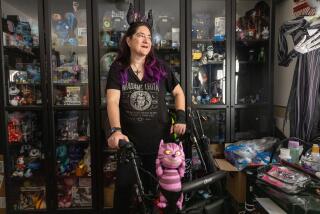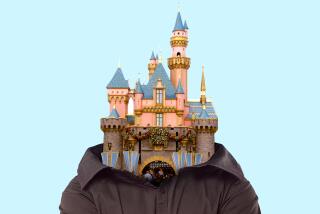Can’t Redheads Have a Little Fun, Too?
- Share via
It was supposed to be a family outing, but “it would have been ridiculous,” Victoria Penley says, if only half of her family had gotten into Disneyland while the other half had to wait outside in the parking lot.
That was the situation Penley says she faced on a Sunday afternoon a year ago. Security personnel had said Penley’s husband and a niece visiting from Vermont could enter the Anaheim amusement park, but she and her teen-age daughter couldn’t because both the color and style of their hair were inappropriate.
But just what was “inappropriate” remains something of a puzzle to Penley, who along with her daughter, Kathryn, has sued Disneyland for $10,000 because of alleged violations of state civil rights laws.
Former School Principal
“I’m a redhead. I’ve had this color hair since I was 10,” the 39-year-old former school principal said in an interview Tuesday from the boutique she now owns in Palm Desert.
And on the day she and Kathryn were denied entrance to the park, Penley said, her daughter’s hair, normally a sandy blonde, had been tinted the same as hers. “It’s the color of Lucille Ball’s, only it’s not so carroty. It’s more a deep auburn,” she said.
Nor was there anything unusual about her or Kathryn’s hair styles, said Penley, describing them as “not quite a shag.” In fact, Penley said, it is the same style she has worn for seven years, including when she served as principal of a Riverside County school for severely handicapped children.
“There weren’t any problems when I was there, and I even went to Disneyland several times with the same color and same style and had no trouble getting in,” Penley said.
Problem Arises
But last May 6 there was a problem, she said, when the four of them, after having bought their tickets at the Disneyland Hotel, tried to take the monorail ride into the park.
“The man taking the tickets said he couldn’t let us go in because our hairdos were inappropriate,” Penley said. “I asked him on what he based his decision, and he said it was his own prerogative. He then suggested we try to get in through another gate.”
Penley said that at the main gate she and the others were met by security personnel, who also denied them entrance.
“They told us they couldn’t admit us because our hair was inappropriate,” Penley said. “They said we would detract from the rides and that because they had people from all over the world coming in, they had to be careful who they let in.”
Penley said she was dressed in designer pants and a long-sleeve silk blouse, and was wearing expensive jewelry. Her daughter was wearing a white button-down collar, shirt and pants, “the kind they sell at Bullock’s and Bonwit Teller and advertise in Vogue magazine,” she said.
Admitted at Knott’s
After leaving Disneyland, the family went to Knott’s Berry Farm in Buena Park and had no problems getting in, Penley said.
A month after the Disneyland incident, Penley said, her daughter toured Europe with the same hair color and style as part of a student ambassadors program.
The family returned to Disneyland later last summer and, although they were stopped again and questioned by security personnel, “We were allowed in because, the man said, we were expensively dressed,” Penley said.
Disneyland spokesman Al Flores, who declined to comment on the Penleys’ lawsuit, said Tuesday that the park has had a dress and appearance code for customers practically since it opened in 1955.
Policy Explained
“We stress for our officers to look at the overall look,” Flores said. “If it looks like a costume, we don’t want our guests to be offended by someone who they might think is an employee, since all of our employees do wear costumes.
“If the overall look is that of a costume or could be construed as offensive, we ask them to make a change if they can. If they can’t, we deny admission.
“We have a reputation for wholesomeness and try to maintain a comfortable atmosphere for our guests. What we’re talking about is the same as a restaurant requiring a coat and tie. As a private facility, we should have the right to maintain a certain atmosphere, and that’s where the policy comes in,” he said.
More to Read
Sign up for Essential California
The most important California stories and recommendations in your inbox every morning.
You may occasionally receive promotional content from the Los Angeles Times.










